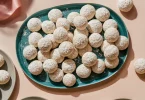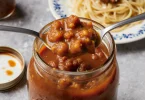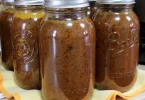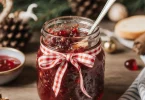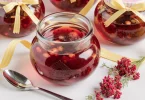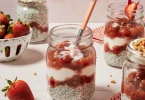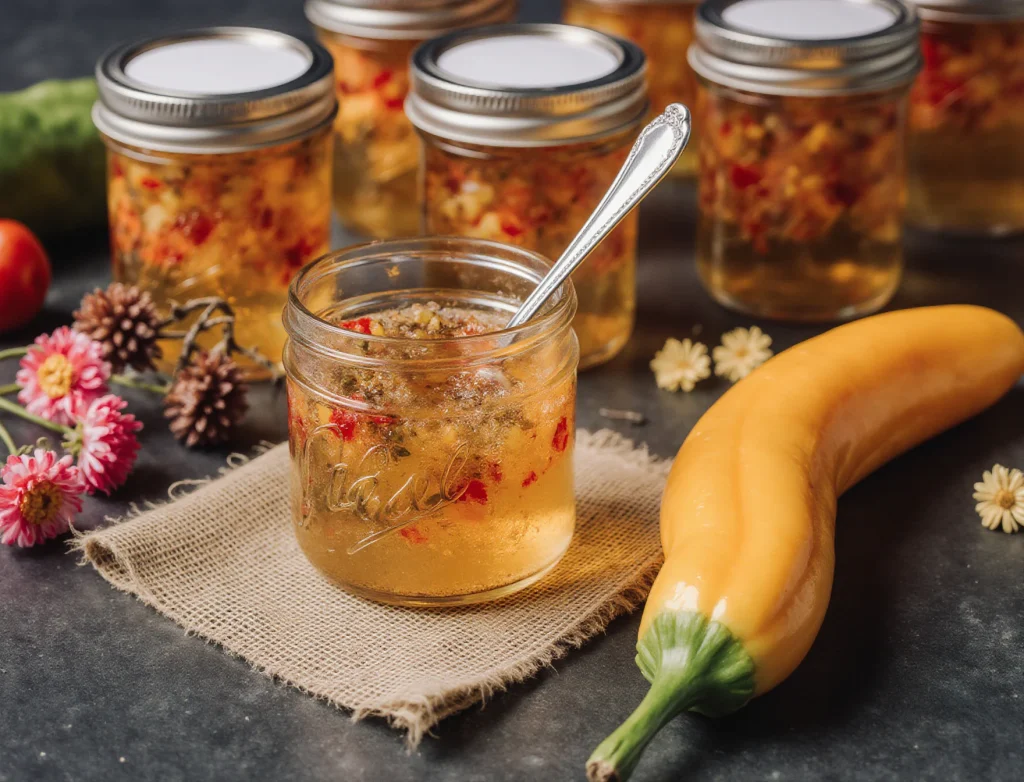
Introduction: Memories in a Jar
Think about the last time you tasted pepper jelly. Maybe it was at a holiday party, spread over cream cheese with crackers. Maybe it was brushed over grilled chicken on a summer evening. Or maybe you opened a jar that a friend gifted you, and the balance of sweet and spicy surprised you in the best way. Pepper jelly isn’t just food—it’s an experience.
By learning the art of canning pepper jelly, you give yourself more than just jars of a flavorful condiment. You give yourself the chance to preserve fresh peppers at their peak, create homemade gifts that everyone loves, and always have a jar of sweet heat ready to brighten up your meals.
This guide takes you through everything you need to know: the best peppers to use, a detailed recipe with ingredients, step-by-step canning instructions, storage tips, flavor variations, common mistakes to avoid, and even creative ways to use your pepper jelly. By the end, you’ll be ready to fill your pantry with jars that carry color, flavor, and tradition.
Why Try Canning Pepper Jelly?
When you make your own pepper jelly, you get benefits that go far beyond what you’ll find in store-bought jars.
- Flavor Explosion: The perfect balance of sweet and spicy makes pepper jelly unique.
- Homemade Quality: You know exactly what’s in your jar—no artificial preservatives.
- Seasonal Savings: Buy peppers in bulk during peak season and preserve them.
- Gift Worthy: Few things impress like a beautifully labeled jar of homemade jelly.
- Versatility: Pepper jelly isn’t just for crackers—it’s a glaze, topping, dip, and sauce enhancer.
Best Peppers to Use for Pepper Jelly
The peppers you choose determine both the flavor and heat level of your jelly.
Sweet Peppers for Flavor and Color
- Bell Peppers: Red, yellow, or orange add sweetness and vibrant color.
- Mini Sweet Peppers: Great for a naturally sweet jelly base.
Hot Peppers for Heat
- Jalapeños: Mild heat with grassy flavor.
- Serranos: A step up in heat with bright notes.
- Habaneros: Fruity and fiery.
- Cayenne or Thai Chilies: For serious spice lovers.
Tips for Choosing Peppers
- Use firm, fresh peppers without blemishes.
- Mix sweet and hot varieties for balanced heat.
- Wear gloves when handling hot peppers to protect your skin.
Ingredients for Canning Pepper Jelly
Here’s a tried-and-true recipe that yields about 6 half-pint jars.
Ingredient Table
| Ingredient | Quantity | Notes |
|---|---|---|
| Bell Peppers | 4 cups (chopped) | Red, yellow, or orange for color |
| Hot Peppers | 1–2 cups (chopped) | Adjust amount for spice level |
| Sugar | 5 cups | Essential for balance and setting |
| Vinegar | 1½ cups | White vinegar, 5% acidity |
| Liquid Pectin | 1 packet | For proper set and texture |
Equipment Needed
- Mason jars (half-pint or pint) with lids and bands.
- Large saucepan or stockpot.
- Food processor for chopping peppers.
- Jar funnel and ladle.
- Jar lifter for safe handling.
- Water bath canner.
- Clean towels for wiping rims.
Step-by-Step Guide to Canning Pepper Jelly
Step 1: Prepare the Peppers
- Wash peppers thoroughly.
- Remove seeds for milder jelly, or leave some for heat.
- Chop finely with a knife or pulse in a food processor.
Step 2: Cook the Jelly
- In a saucepan, combine peppers, vinegar, and sugar.
- Bring to a rolling boil, stirring constantly.
- Add liquid pectin and boil for 1 full minute.
- Remove from heat and skim foam if necessary.
Step 3: Fill the Jars
- Ladle hot jelly into sterilized jars, leaving ¼-inch headspace.
- Wipe rims with a clean damp cloth.
- Place lids on top and screw bands finger-tight.
Step 4: Process in Water Bath
- Place jars in boiling water bath for 10 minutes (adjust for altitude).
- Carefully remove jars with a lifter.
- Let cool 12–24 hours undisturbed.
- Check seals before storing.
Flavor Variations for Pepper Jelly
Once you master the classic, try these creative twists:
- Cranberry Pepper Jelly: Add cranberries for a tart holiday version.
- Mango Pepper Jelly: Sweet tropical flavor balances spice.
- Garlic Pepper Jelly: A savory twist with minced garlic.
- Extra Hot Jelly: Use habaneros or ghost peppers for fiery heat.
Storage and Shelf Life
- Sealed Jars: Store in a cool, dark pantry for 12–18 months.
- Opened Jars: Refrigerate and use within 2–3 weeks.
- Freezing Option: Freeze instead of canning if desired.
Creative Ways to Use Pepper Jelly
Pepper jelly is more than just a cracker topping. Try these ideas:
- Spread over cream cheese for appetizers.
- Glaze for chicken, pork, or salmon.
- Stir into sauces or salad dressings.
- Use as a burger or sandwich spread.
- Top baked brie for a party dish.
Common Mistakes to Avoid
- Skipping Gloves: Hot peppers can burn skin and eyes.
- Overcooking Jelly: Can result in rubbery texture.
- Not Adding Enough Vinegar: Needed for safe acidity.
- Improper Sealing: Leads to spoilage.
Frequently Asked Questions About Canning Pepper Jelly
How spicy will my jelly be?
It depends on the type and amount of hot peppers. Adjust to taste.
Do I need a pressure canner?
No, water bath canning is safe since vinegar makes the recipe acidic enough.
Can I use powdered pectin instead of liquid?
Yes, but follow package directions for substitutions.
Can I reduce the sugar?
Sugar is essential for balance and proper set. Reducing may alter results.
How long does homemade pepper jelly last?
Sealed jars last 12–18 months. Opened jars keep 2–3 weeks in the fridge.
Conclusion: Sweet Heat in Every Spoonful
Canning pepper jelly is more than just preserving peppers—it’s preserving tradition, flavor, and creativity. With simple ingredients, a little time, and safe canning methods, you can fill your shelves with jars of jewel-colored jelly that bring sweet heat to any meal.
Whether you’re spreading it on crackers, glazing meats, or gifting jars during the holidays, pepper jelly is a recipe worth adding to your canning collection.
Call to Action
Now it’s your turn: gather your peppers, sugar, and jars, and try canning pepper jelly for yourself.
👉 Share this guide with a friend or comment below: Do you prefer your pepper jelly mild and sweet, or fiery and bold?
Don’t forget to subscribe for more canning guides, homestead recipes, and kitchen inspiration.


